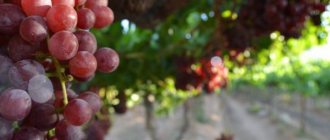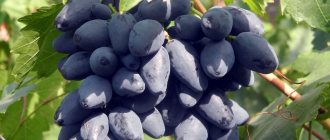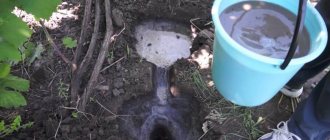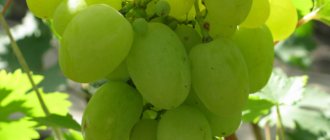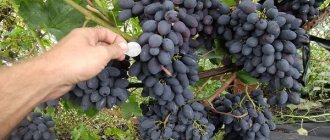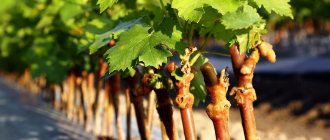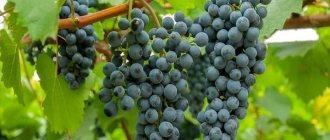Fruits and berries » Grapes
0
1296
Article rating
Kira Stoletova
Jaguar grapes are early crops that produce a harvest in early July. This variety is considered an ideal option for those who want to harvest a large harvest and not spend a lot of time caring for the plant.
Description of Jaguar grapes
Description of the Jaguar grape variety
The Jaguar grape variety is characterized by vigorous, powerful bushes, up to 4 m high. The shoots have great vigor. The vine ripens well, more than 2/3 of the entire length. Begins to bloom in early summer. The flowers are male and female. The foliage is dark green. The surface is not shiny, rough. The leaf blade is serrated along the edges.
The grape fruits are oval, elongated. The weight of the Jaguar berry is 14–16 g, size 32x34 mm. Their color is pink-violet. According to the description, after full ripening the grapes acquire a red-violet hue, which is clearly visible in the photo of the Jaguar variety. The skin is medium thick, soft, and easy to eat. The bones are small, there are not many of them. The density of the pulp is medium, crispy, pink in color. The taste is harmonious. The brushes are conical, large, dense. The weight of one hand is 1–1.5 kg. The length is 40–50 cm. Light peas are observed. Jaguar bunches have a marketable appearance. The finished berry stays on the stalk for a long time and does not fall off.
Characteristics of the variety
When choosing grapes, it is important to focus on the following indicators:
- productivity;
- taste and use of fruits;
- resistance to weather changes, diseases, pests.
The more a variety meets these requirements, the correspondingly higher its demand.
Drought resistance, frost resistance
Jaguar grapes are considered a cold-resistant variety. Able to withstand temperatures down to -24 °C, the frost resistance zone is high. For a berry bush, the indicators are decent, but shelter is required for the winter. Drought resistance is high.
Productivity and fruiting
Grape variety Jaguar mid-early ripening. The berries ripen in the first half of August. The duration of the period from bud break to full maturity is 115–120 days. Jaguar's productivity is consistently high. When planting 3x2 m you can get 15 kg. Fruiting with 5–8 buds. On one bush, as a rule, there are 35 buds, they are loaded with shoots in the amount of 20–24 with a feeding area of more than 4 square meters. m.
The berries are well preserved on the bush for a long time without losing their taste. There were no cases of fruit cracking during heavy rains. They do not bake in the sun due to their thick skin.
Judging by the reviews, there is no muscat tint in the Jaguar grape; the variety is not aromatic. The taste is pleasant, sweet and sour due to the high content of sugar and ascorbic acid. Sugar content – 17–19%, acidity – 7–9%.
Attention! The influence of unfavorable factors on Jaguar grapes is still being determined.
Area of application of fruits
Jaguar grapes are classified as table varieties. Universal application. The fruits are consumed fresh, dried and processed. Used for preservation and making homemade wine. This grape variety has excellent transportability and storage parameters. In the basement, the bunches can remain for up to 3 months without losing their presentation.
Resistance to diseases and pests
The Jaguar grape variety has good immunity to fungal diseases and pests. Stability:
- to mildew at 3.5 points;
- to oidium – 3.0 points;
- to gray rot – 3.5 points.
The general indicators of disease resistance of the grape variety are in the range of 2.5–3 points. The response to other diseases of berry crops is still being tested. The main enemies of Jaguar grapes are wasps, midges, and rodents. During growth and development, regular treatment against ailments and insect pests is required.
Advantages and disadvantages of the variety
To understand the capabilities of Jaguar grapes, you should study the description. But when there are a number of characteristics that have not yet been completely studied, you can determine the strengths of a variety based on reviews:
- large hand weight;
- high frost resistance;
- good taste;
- disease resistance;
- after ripening, the fruits do not fall off;
- easy reproduction;
- transportability of the crop.
The disadvantages of the Jaguar grape variety are:
- need for shelter for the winter;
- susceptibility to fungal diseases.
How to plant
Let's get acquainted with the rooting features of this berry fruit bush.
Deadlines
Experts advise rooting this grape in the spring. It is necessary to choose the moment early, before the plant buds open. If there is a need to postpone the deadline, store the planting material in the refrigerator or cellar.
If the climate in the region is very warm, autumn planting is also acceptable: before the onset of cold weather, the grapes will have time to take root. In cool regions there is only one choice - spring.
Selecting a location
Grapes should be planted on the site:
- sunny;
- perfectly heated;
- protected from drafts and wind.
The best option is to plant the vine along the fence on the south side.
Pay attention to the soil: it should be nutritious and loose
Selection and preparation of seedlings
You should carefully and very carefully select planting material in this case. If you make the wrong choice, it is unlikely that you will be able to grow a high-quality vine and get good harvests.
Please note the following points:
- the roots of the young plant must be well developed and show no signs of rot or damage;
- if the seedling is grafted, the scion and rootstock should already grow together completely;
- a high-quality seedling is at least half a meter long;
- the plant must have at least three developed fruit buds;
- There should be no damage or defects on the seedling, as well as mold, rot, and black areas.
Preparation
Before planting the plant, its roots must be shortened to the same length. The next step is to soak the roots in water, then into a clay mash.
Boarding procedure
- First, a hole with dimensions of half a meter by half a meter is dug in the area. The depth is the same or a little more.
- In the immediate vicinity of the hole, a support is driven into the ground - preferably made of metal.
- Soil mixed with fertilizers is placed in the hole: the hole is filled one third with this mixture.
- The seedling is carefully placed in the hole, its roots are spread along the bottom.
- The plant is sprinkled with loose substrate on all sides and compacted.
- Watering is carried out at the rate of 2 buckets of warm water per bush.
Important: if several plants are planted, keep a distance of 2 meters between them, leave 4 meters between the rows.
Let's find out how to care for Jaguar grapes further.
Watering
- In this case, it is necessary to moisten the soil abundantly, but not excessively.
- The optimal frequency of water procedures is once every 10-14 days.
- For one procedure, 2-3 buckets of water are consumed per bush.
After watering, we recommend loosening the soil to increase its permeability and break up the hard crust on top. At the same time, remove the weeds.
Top dressing
Jaguar grapes should be fertilized as needed. Monitor the health of the plant: if flowering is not in a hurry, add potassium nitrate. To make the bunch grow larger, superphosphate will help.
Once every two years, fertilizing is done with organic compounds that improve the structure and composition of the soil.
Trimming
The crop is pruned according to the same principle as all table varieties.
The procedure is carried out for the first time after a two-year period has passed from the date of planting. All shoots are subject to pruning, except for the two lateral ones and the central one, of course.
It is imperative to remove broken, damaged and diseased branches in a timely manner. In this case, you don’t even have to wait for the deadline for the “official” procedure, but get rid of the garbage immediately.
Reproduction
Like other grape varieties, Jaguar also reproduces vegetatively. The cuttings of the plant quickly take root and then actively grow. Problems usually do not arise with this, even for inexperienced gardeners.
Protective measures
Jaguar grapes are disease resistant, but they should be protected from pests and rodents.
To prevent rodents from getting to the plant, gardeners build a protective stone slide around the trunk. The height of such a “fortress wall” should be at least 30 cm.
It is very effective to use a drug such as Regent against pests. This product is used to spray the soil around the grape trunk - and not a single pest will get through.
They protect themselves from wasps using special mesh bags for the bunches. The barriers made of rigid mesh that surround the vineyard will help control the birds.
Late blight is also a danger for this grape variety. Gardeners usually use Bordeaux mixture to prevent this fungus.
Rules for planting grapes
To obtain annual high yields of berries, it is important to plant seedlings correctly and follow all the rules for caring for shrubs. Only in this way will maximum fruiting be ensured.
Recommended timing
It is preferable to plant Jaguar grape seedlings in the spring, before the buds open. Sometimes it is necessary to shift the deadlines, but then it is necessary to place the planting material in a cellar or refrigerator so that the reserves of nutrients and moisture are not depleted.
In the southern regions, where the soil freezes shallowly, grape cuttings can be planted in the fall. In areas with a cold climate, it is optimal to plant in April or May.
Attention! The recommended timing for planting Jaguar grape seedlings depends on the climatic characteristics of the region.
Choosing a suitable location
Jaguar grapes prefer well-lit, sunny areas. In addition, it is important to protect the plant from the winds during the cold season. Often choose places along the fence located on the south side. It is worth considering the distance between the rows - it should be equal to the distance between the bushes. The grape culture grows well in fertile, light soils. For normal fruiting, Jaguar will need 4–6 square meters. m area.
Selection and preparation of planting material
The most stringent requirements are imposed on grape seedlings, since with low quality the bushes do not take root well and the harvest is correspondingly weak. Before purchasing planting material, you should pay attention to:
- well developed root system;
- in grafted seedlings - dense fusion of the rootstock and scion;
- length up to 50 cm;
- the presence of at least 3 kidneys;
- bark without obvious damage.
Preparation for planting in the ground involves pruning the root system and growth. Then the roots of the grapes are soaked in water. A few hours before the procedure, the seedlings are placed in a clay mash.
Landing algorithm
The procedure includes:
- Prepare a planting hole 50 cm deep.
- The hole should be oriented from north to south, so the Jaguar grapes will be illuminated by the sun all day long.
- The distance between bushes is 4 m, between rows - 2 m.
- Metal supports 2–2.5 m high are dug in next to the recess. They are connected to each other by wire in several rows. Such a support will protect the seedling from the wind and prevent it from deforming.
- The hole is filled 1/3 with fertilizers mixed with soil. You will need: humus - 5 kg, potassium nitrate - 40 g, superphosphate - 30 g.
- The roots are placed in the hole and carefully straightened.
- Sprinkle with earth. There is no need to tamp tightly.
- The last stage is watering. For each bush you need 2 buckets of warm water.
Forum statistics
207036 Messages in 1634 Topics from 5593 Users. Last user: Amaya Last message: “Let's talk about the weather in Vash...” ( Today at 07:52:22 ) Latest messages on the forum.
Now on the forum
34 Guests, 10 Users
Users in the last 15 minutes: therapist, 64nikolay64, Marshal, Svetla777, Liza, lomakin1969, Alexander Vl., Elvira2017, Andrey76, Slavka [Blocked] [Section Moderator] [Forum Moderator]
Maximum online today: 77 . All-time maximum online: 2758 (28 July 2021, 17:22:51)
Users who visited the forum in the last 24 hours
Total: 295
(Visible: 294, Hidden: 1) 1963, therapist, 64nikolay64, Marshal, Svetla777, Liza, Capricorn, lomakin1969, Alexander Vl., Elvira2017, Andrey76, Slavka, Mikhail77, ElenkaF, Tatyana B, Alex65, Cherkessk, Eugene, zsb, Leonidych, vladimirM, yotmast, mers, Serg1707, SNovichek, hanter64, znakomij, Alexander K, Vardan, Sergey Fer, Anatoly Sivkov, Alexey V, Ilya 77, Andrey Gladilin, Tatyana A., Belgorodets, in Astrakhan, Oksana Kopp, sem_en, Vladimir 153, skier, Igor Viktorovich, slavalimon, Primorets, OlgaOs, SANYCH, 31rus, mystic69, DorontsovPeter, Andrey Tsvetkov, Buba, igor222, Elena Z, vlad51, Kenig, Nikolay Rex, Sergey 1965, Vladimir Buturlakin, DSW, psv1960, Dmitry 77, Vasily V., Vyacheslav03, Natalia Nikolaevna, Sergey Tashchiyan, Nikolay S., Igor Sergeevich, alexsandr, kvg, Pioneer, Ekaterina Polyanina, nicson7, Elena Aleshchenko, Alexander-ask-34, Verona, Igor F., Taker, Tikhii , Henry, Yuri72, L.A.P., Gaivoronsky Yuri, Sergeevich, Sergei Chistokletov, Svetlana Streletskaya, Galinka, Alexey Deminov, Naumov Igor, Vyacheslav136, Gloomy, Katrin, AndSanych, Mikhno Alexander, Ded31, Filippov Oleg, Vladimir ++ , Mikhail Alekseevich, Lydia58, ALEXANDER BRYANSKY, Vladimir-kanevskaya, DIL, Amber7394, Marina Protasova, TITOVA LYUBOV, Linx, alexander66, Natalya M, Mikhail Fesenko, Amaya, Alexander71, Boris 1952, tsv, Maximilian, 25nata35, nadia, GALINA A NOKHINA , Igor_K, Alexander Kolesnikov, Ivan Levin, Pitko, weather forecaster, eSAa, cecet71, atseton, Alexander Smirnov, Vladimir Kostochkin, Vladimir Berdnikov, Gocha, pioneer-2, LeXa_KoT, Sergey 61, Sergey Yuryev, Erem, alexss, Evgeniy52, Skif, Vladimir Kovba, dayton, Yuri Semyonov, N.A. Sokolov, Pavlentiy, Sa-shura, Volgogradka, Dmitry Anatolyevich, Grandfather Igor, Andrey Lis, Bublichenko Alexander M, Marina Krymskaya, stenlly2010, irahelm, Vyacheslav Vladimirovich, Vladimir Shilov, Aprel, Badaev Dmitry, gheo55, Yura, y_fed, rambo, Yagodka, Valentina Ivanovna, Kryn, oleg9f, DED2, Svetlana Korotina, Zavezen Oleg Ivanovich, Eduard., santra, L2k2m7n, Alexander48, Viknik, Andrey 31, m2d, Valery Rastorguev, Soshnin Yura , Amateur gardener, Galina, Vasily1111, gardener, marlin64, Salex, sergei, Sergey Ko, Ramiz, viktor_, kosmos, potap05, Yuri 36, VitalySD, Inna161, Vova Kapran, Vladimir Shcherbinin, Valerie, niy1, cfibr, Andrey68, kulol3 , thanatos, Serzh1978, Realist, Artur53, max2008-01, LOZA, AlexanderD, Grandfather Young, Natasha, Zayac, ketch, Rita, alx-74, Iv Iv, Alexander150, Igor K, Vasily Viktorovich, VeraNiK, kdm57, Veniaminovich, Boris Sokolyansky, 77volt, , vikbublik, neposny, Evgen, Victoria Aleksandrovna, Serezha 64, Wintel, Airbone, teri, Sergey Lomonosov, Khramov, serginio, Leonty Yarygin, Irina O., Ser, Nadezhda Grig, Lyubov S., netolya, Saisan, Agryzkov Alexey, Vadi, Zinaida, Vadim, Alexander Taganrog, Sukhonos Sergey, Snezhinets, evgen_26, nau_63, Masha_gardener, Gennady163, krasnovlad1, Alexander Zinoviev, Vasily 53, Roman Fedorovich, TIS, Alexey Sergeevich, arnyusha, Zheka, Nurtas, kradievska, nick041 , Valentina Medvedeva, Sergey43, Andrey S., Nikolay Lipunov, Mst, Vertuoz2, Vladimir VS, NatalyaMed, freesia, Kinna, Mikhail Michurinsk, alekcsan1, VALERY TAMB, Sasha57, MikhAf, Y_Azer, Andrey Beribesov, hunter1955, nut lover, Keys, Ivan Shmelev, Pestik, anton_slash, Nadymchanka, Sergey 31, Volgar, Pavel 64, Tatyana Volzh, Elektronik_t, Alexander 61, spotlight, Alexander Guy, Cheprak, Pirko Alexander, vladimirvrn
Aftercare for grapes
Further care for Jaguar grape bushes involves a set of simple measures.
- Watering is needed abundantly, but you should not over-moisten the soil. It will be enough to moisten the plant once every 10–14 days. The volume of liquid is 20–30 liters per bush.
- Carry out loosening regularly, eliminating the dense earthen crust. This way the roots are saturated with oxygen.
- Remove weeds in a timely manner.
- Fertilize Jaguar grapes as needed. If the flowers do not set well, then it is worth feeding with a solution of potassium nitrate in a volume of 25 liters. To enlarge the bunch, use a superphosphate solution.
- Every two years, feed with organic fertilizers, in particular humus, 3 kg per bucket of water.
Grape pruning
Pruning Jaguar grapes follows the same principle as table varieties. The first time the procedure is carried out 2 years after planting. All shoots are trimmed, excluding the central and two lateral ones. Diseased shoots are subject to subsequent removal.
Important! The essence of pruning grapes is to remove the tendrils and form the shoots so that no more than 8 eyes remain on them.
Protecting crops from birds and insects
To protect the crop from rodents and for preventive purposes, a stone hill is built around the trunk up to 30 cm high. An effective chemical preparation against them is “Regent”. You need to spray the soil around the plant with a solution of this product. Wasps are controlled by using insecticides, hanging sticky tape, or placing gauze bags on the bunches. The birds are stopped by a rigid mesh barrier in which they can become entangled.
Preparing grapes for winter
In autumn, green shoots and vines that have given up their harvest are cut off. Dig up the soil around the bush so that water is better absorbed and, accordingly, the root system does not freeze.
Despite the fact that the Jaguar grape variety is considered frost-resistant, shelter for the winter is necessary. First of all, the vine is removed from the trellis and bent to the ground. To prevent it from straightening up, they pin it down. Film and straw mats are laid under the tied shoots. The top can be covered with natural material: sawdust, hay, spruce branches. Next, wrap everything with agrofibre or other airtight material.
Preparing for winter
It would be a good idea to dig up the soil under the vine - in this case, the moisture will be absorbed much better and the plant will not freeze too much. In autumn it is also recommended to prune the vine. Green shoots and fruit-bearing vines are cut off.
Jaguar grapes are considered frost-resistant, able to withstand frosts down to -20? S. Therefore, in the southern and middle regions there is no need to hide it. It is enough to carefully remove the vines from the trellis, tie them and tilt them towards the ground. To prevent the vines from straightening out, they are pinned to the ground.
In much northern regions, it is recommended to make additional shelter - branches and film are placed under the tied vines. And on top of the Jaguar grapes they cover it with any “warm” material - sawdust, boards, straw mats.
Viticulture is very exciting; you just need a little patience and diligence. A large variety of varieties makes it possible to select grapes that are suitable for growing conditions and taste.
Diseases and pests, control methods and prevention
Jaguar grapes mainly suffer from late blight and gray rot. You can deal with them using a solution of Bordeaux mixture. Fungal diseases such as powdery mildew and oidium are destroyed with lime, sulfur-containing preparations, and systemic fungicides.
But bacterial cancer is not so easy to deal with. With this disease, the bushes are uprooted and subsequently burned.
Preventive measures will help cope not only with the above ailments, but with other diseases characteristic of grapes. It will be useful:
- sanitary pruning of vines;
- weed removal;
- collecting fallen leaves;
- treating the bush with folk remedies or chemicals;
- fertilizing with mineral fertilizers.
Reviews
Let's find out how gardeners respond to Jaguar grapes.
Three years ago I planted Jaguar grapes in my yard. I have already harvested my first harvest: the berries are large, juicy, and aromatic. The vine does not require shelter - our climate is warm. I'm happy: the care is simple, and the harvest is great. But it is necessary to protect it from birds and wasps.
Few people grow grapes in our area—I’m one of those eccentrics. I try to plant cold-resistant varieties, but recently I planted Jaguar. Then I only found out that he loves warmth, and our cold winters are not suitable for him. But probably because, in any case, I cover the vineyard well for the winter, the bush has successfully survived two winters. I think things will continue to be no worse. I am pleased with the harvest: I have never grown such sweet grapes.

